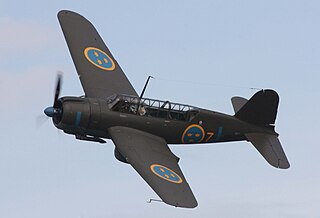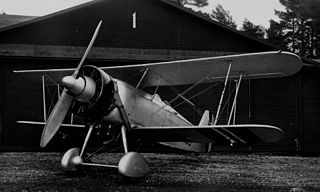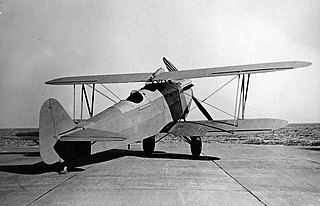Related Research Articles

The Saab 17 is a Swedish single-engine monoplane reconnaissance dive-bomber aircraft of the 1940s originally developed by ASJA prior to its merger into Saab. It was the first all-metal stressed skin aircraft developed in Sweden.

The FFVS J 22 was a Swedish single-engine fighter aircraft developed for the Swedish Air Force during World War II.

Svenska Aero Jaktfalken ("Gyrfalcon") was a Swedish biplane fighter aircraft, constructed in the late 1920s. The aircraft was first manufactured by Svenska Aero and later by AB Svenska Järnvägsverkstädernas Aeroplanavdelning (ASJA).
The Arado SD II was a fighter biplane developed in Germany in the 1920s. Like the preceding SD I, it was intended to equip the clandestine air force that Germany was assembling at Lipetsk and was hoped to overcome the shortcomings of that type. Although it shared the same basic configuration, the SD II was an all-new design. A considerably larger and heavier aircraft, it had wings of less stagger, braced with conventional wires. The landing gear and tailplane were of far stronger construction.

The Arado SSD I was a biplane fighter seaplane developed in Germany in 1930, intended to be launched from catapults on warships. This was an all-new design from Walter Rethel, sharing nothing with his other fighter designs for Arado of the late 1920s. It was a conventional unequal-span, staggered biplane, with the slightly gulled top wing attached to the upper fuselage. It was equipped with a single, large float under the fuselage and two outrigger floats near the wingtips. After evaluation at Travemünde, the floats were removed and a simple, wheeled undercarriage was fitted for competitive evaluation with the Heinkel HD 38 at Lipetsk. The Heinkel was selected, and the SSD I was relegated to trainer duties with the LVS in 1932.

The Heinkel HD 42 50, later designated the Heinkel He 42 was a German two-seat biplane seaplane originally designed for the Deutsche Verkehrsfliegerschule, and later built for the German Luftwaffe. The aircraft was used until the end of World War II as a trainer for maritime pilots.

The Heinkel HE 5, produced in Sweden as the Svenska S 5 and nicknamed the "Hansa", was a reconnaissance floatplane built during the 1920s. It was a further development of the HE 1, sharing its same basic configuration as a low-wing, strut-braced monoplane. The HE designation also refers to the monoplane construction, standing for Heinkel Eindecker.

The Heinkel HD 28 was a reconnaissance seaplane developed in Germany in the 1920s for export to Japan. It was a conventional single-bay biplane with equal-span, unstaggered wings and three cockpits in tandem. The fuselage was braced to both the upper and lower wings with a number of struts on its sides, in addition to the normal cabane struts. The rudder extended below the line of the lower fuselage, and there was a large ventral fin fitted. The rearmost cockpit incorporated a ring mount for a gunner.

The Heinkel HD 24 was a training seaplane developed in Germany in the late 1920s. It was a conventional single-bay biplane with equal-span, staggered wings. The fuselage was braced to both the upper and lower wings with a number of struts on its sides, in addition to the normal cabane struts. The pilot and instructor sat in tandem, open cockpits, and the undercarriage consisted of twin pontoons, although this could be readily exchanged for wheels or skis.

The Heinkel HD 35 was a trainer developed in Germany in the 1920s. It was a conventional single-bay biplane with staggered wings of equal span. The design was based on that of the HD 21, and like that aircraft, it had three open cockpits in tandem, although the most forward of these was usually faired over when not in use.
The Heinkel HD 26 was a reconnaissance seaplane developed in Germany during the 1920s for production in Japan. It was intended as a smaller, single-seat counterpart to the HD 25, to provide a spotter aircraft for warships, to take off from a short ramp. The HD 26 was a conventional biplane with staggered wings, twin float undercarriage, and an open cockpit.

The Heinkel HD 38 was a fighter aircraft developed in Germany in the late 1920s. It was a compact, single-bay biplane with staggered wings of unequal span, braced with N-type interplane struts, a refined version of the HD 37 that had been evaluated and rejected by the Reichswehr for use at the secret training facility at Lipetsk. The HD 38 was designed in the hope of capturing a different niche - that of a seaplane fighter, and was designed with a twin pontoon undercarriage that could be quickly removed and replaced with wheels. It was accepted in this role, but did not serve in it for long before being relegated to general training duties. Even then, it was not long before Germany abandoned the Lipetsk base to the Soviet Union.

The Aichi E3A was a reconnaissance seaplane developed in Germany as the Heinkel HD 56 to operate from warships of the Imperial Japanese Navy, which designated it the Type 90-1 Reconnaissance Seaplane. It was a conventional single-bay biplane with staggered wings braced by N-type interplane struts. The pilot and gunner sat in tandem, open cockpits.
The Heinkel He 62 was a reconnaissance seaplane designed in Germany in the early 1930s. It was a conventional, single-bay biplane with unstaggered wings of equal span. The pilot and gunner sat in tandem, open cockpits. A few aircraft were supplied to Japan, where Aichi built a version as the AB-5, and used it as the basis for the AB-6, but no series production took place. The AB-5 used a locally produced Nakajima Kotobuki in place of the Siemens engine fitted to the German-built aircraft.
The Yokosuka E5Y was a single-engine Japanese seaplane used for reconnaissance. The E5Y was also built by Kawanishi as the E5K

The Heinkel HD 14 was a single-engine biplane torpedo aircraft developed by the German aviation company Ernst Heinkel Flugzeugwerke in the 1920s, and produced in a single prototype, under license, from Swedish by Svenska Aero in Stockholm.
The Heinkel HD 16 was a single-engine biplane torpedo aircraft developed by the German aviation company Ernst Heinkel Flugzeugwerke in the nineteen-twenties and produced under license by Svenska Aero in Stockholm, Sweden.
The Heinkel HD 15 was a single-engine biplane seaplane, developed by the German aeronautical company Heinkel Flugzeugwerke in the late 1920s and remained at the prototype stage.
The Heinkel HD 30 was a biplane reconnaissance seaplane developed by Ernst Heinkel Flugzeugwerke.

The Heinkel HD 41 was a reconnaissance aircraft developed in Germany in the 1920s.
References
- ↑ "Heinkel HD-19". www.airwar.ru.